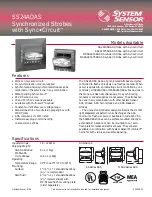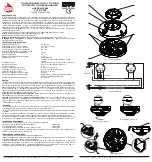
Installation & Commissioning of Control & Monitoring Add On’s
Page: 13
When the second zone goes into alarm, then the following steps are followed
9
Auto release activated LED on the Agent Release Module and Local Control Station goes
steady
9
Stage 2 outputs are pulsed during the pre-release delay to +24VDC
9
Start optional pre-release delay. (Selected via FACP on-site programming).
9
Upon expiration of the delay, activate the selected activation circuit and stage 2 outputs
becomes steady.
9
Light the Agent Released LED on the Agent Release Module and Local Control Station
when the pressure switch input on the termination board is activated (depends on the
pressure switch configuration).
9
FACP to activate the Fire output and illuminate the Fire LED
The operation of the Hold switch is as per the Manual Release.
Released Condition
When the agent has been released, and the pressure switch input has been activated, then the
board is in the released condition. The condition is shown by:
9
Agent Released indicator is lit at the Agent Release Module and Local Control Station
9
FACP Fire output and associated indicator is On.
The condition remains until reset has been activated at the FACP.
It is possible, when the agent release module is in the released condition to de-activate the Stage
1 and Stage 2 outputs. This is achieved by depressing the SILENCE/RESOUND button at the
FACP. This action will also silence the alarm outputs at the FACP and the sounder outputs on the
8 way sounder board (if fitted). If the SILENCE/RESOUND button is depressed again to instigate
the RESOUND facility, then the stage 1 and stage 2 outputs will be re-activated (as will the
onboard alarm outputs and sounder outputs on the 8 way sounder board if fitted).
Lock-Off Valve
When the lock-off valve is operated, the agent is blocked from reaching the release valve. When
the lock-off valve is operated, the following occurs:
9
Light the Blocked Mode indicator at the Agent Release Module and Local Control Station
9
Operates
the
system inoperative output
Fault Monitoring
The sources of fault in the system are:
9
Pressure switch monitoring circuit
9
Low pressure switch monitoring circuit
9
Lock-off valve monitoring circuit
9
Activation
circuit
9
Stage 1 outputs
9
Stage 2 outputs
9
Fault in the trigger zones
9
Fault with a Local Control Station
Note #1:
The common fault indicator on the Agent Release Module and Local Control Station is
illuminated for any Fault condition.
Note #2:
For a pressure switch fault, low pressure switch fault, lock-off valve fault, stage 1
output fault and stage 2 output fault the FACP will signal the brigade.
Note #3:
When there is a fault in the activation circuit or in the trigger zones, in addition to the
above, the system inoperative output is operated.
Note #4:
The FACP buzzer sounds for all faults and the LCD displays the type of fault.
Note #5:
The FACP will report the type of fault on the LCD.

































